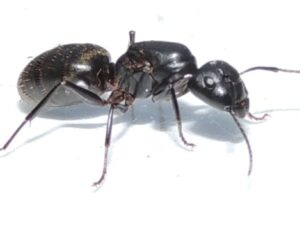St. Catharines, St. Catharines! The carpenter ants are coming, the carpenter ants are coming! Once in your home they can destroy anything made of wood. Unlike termites, they don’t eat wood. Oh, just burrow to make carpenter ant colonies. Completely damaging major structural elements of buildings. So, the next summer afternoon there’s an ant in your kitchen don’t just stomp on it and carry on eating watermelon. Take a closer look.
Carpenter ants are commonly black with red or yellow hues. Take note of their size because carpenter ants are generally quite large. They are nearly five times the size of typical street ants. Like the standard ant body type they consist of a head, thorax and abdomen. Carpenter ants have large mandibles, like scissors, coming from the front of its face. Elbow shaped antennas stick out of its head. Six legs extend from the thorax with a narrow waist separating from the abdomen. Also, it's decorated with long, yellowish hairs unique to the carpenter ant. The most telling feature is that the ant only has one node, like a small notch, between the thorax and abdomen. Many other types of ants have two nodes.
 Cleanliness is priority for carpenter ants. Unlike termites, who will make a huge mess building their nests, carpenter ants will keep their galleries clear of debris. Near the entrance there might be frass or a small amount of sawdust. This is basically their garbage pile consisting of wood, insect parts or other excrements carried out of the nest. The dream location for a carpenter ant is somewhere that protects them from predators and weather while easily accessible to food. Also, they prefer moist wood. Places like decks, porches, windows, and roofs are optimal spots for their home.
A magnifying glass might not be enough to spot the characteristics of a carpenter ant. It’s actually quite difficult to identify one of North America’s largest ants. If you suspect a carpenter ant infestation contact St. Catharines’ Truly Nolen Pest Control. They will come and identify the main colony, remove any ants and assess the damage.
Cleanliness is priority for carpenter ants. Unlike termites, who will make a huge mess building their nests, carpenter ants will keep their galleries clear of debris. Near the entrance there might be frass or a small amount of sawdust. This is basically their garbage pile consisting of wood, insect parts or other excrements carried out of the nest. The dream location for a carpenter ant is somewhere that protects them from predators and weather while easily accessible to food. Also, they prefer moist wood. Places like decks, porches, windows, and roofs are optimal spots for their home.
A magnifying glass might not be enough to spot the characteristics of a carpenter ant. It’s actually quite difficult to identify one of North America’s largest ants. If you suspect a carpenter ant infestation contact St. Catharines’ Truly Nolen Pest Control. They will come and identify the main colony, remove any ants and assess the damage.
 Cleanliness is priority for carpenter ants. Unlike termites, who will make a huge mess building their nests, carpenter ants will keep their galleries clear of debris. Near the entrance there might be frass or a small amount of sawdust. This is basically their garbage pile consisting of wood, insect parts or other excrements carried out of the nest. The dream location for a carpenter ant is somewhere that protects them from predators and weather while easily accessible to food. Also, they prefer moist wood. Places like decks, porches, windows, and roofs are optimal spots for their home.
A magnifying glass might not be enough to spot the characteristics of a carpenter ant. It’s actually quite difficult to identify one of North America’s largest ants. If you suspect a carpenter ant infestation contact St. Catharines’ Truly Nolen Pest Control. They will come and identify the main colony, remove any ants and assess the damage.
Cleanliness is priority for carpenter ants. Unlike termites, who will make a huge mess building their nests, carpenter ants will keep their galleries clear of debris. Near the entrance there might be frass or a small amount of sawdust. This is basically their garbage pile consisting of wood, insect parts or other excrements carried out of the nest. The dream location for a carpenter ant is somewhere that protects them from predators and weather while easily accessible to food. Also, they prefer moist wood. Places like decks, porches, windows, and roofs are optimal spots for their home.
A magnifying glass might not be enough to spot the characteristics of a carpenter ant. It’s actually quite difficult to identify one of North America’s largest ants. If you suspect a carpenter ant infestation contact St. Catharines’ Truly Nolen Pest Control. They will come and identify the main colony, remove any ants and assess the damage.

